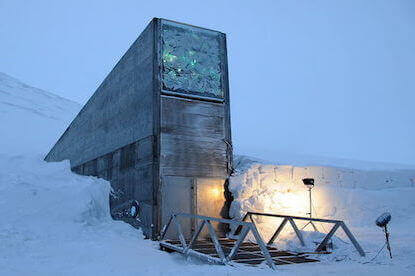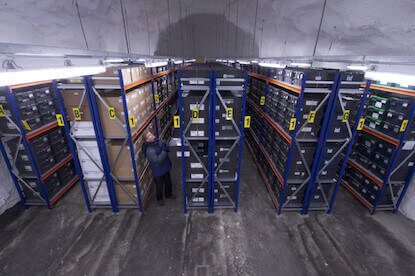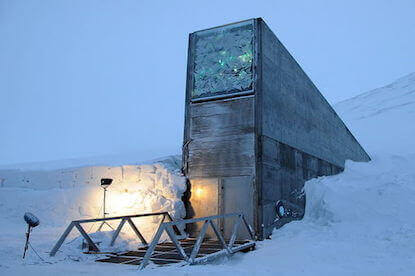Food Bank
The Svalbard Seed Vault Protecting Seeds Of The World
A food bank or seed vault like the Svalbard Seed Vault in Norway guards against potential threats from change in unnatural plant reproduction from the introduction of GMO seeds.
Most people think of a food bank as a place in a community where the less fortunate can come and get canned goods and other non-perishable food. But there is another type of food bank that has more than a few citizens concerned.



The term “green revolution” described an effort in the 1960’s to modernize agriculture in the third world – and it worked. Not soon after there was an explosion in food production as farmers and peasants used these modern methods to till fields, find untapped water resources and plant newly invented generations of seeds. No one realized that this massive expansion in agricultural activity would deplete valuable resourses at such an alarming rate. Now the developing world is experiencing water and food shortages that are leaving billions hungry and millions starving.
In an effort to address these problems, organizations like The World Food Bank and The United Nations have teamed up with the major GMO agribusiness giants to introduce their patented seeds across Africa under the deceptive label, "bio-technology", the new name for genetically modified seeds.
The term bio-technology attempts to hide the fact that the latest GMO seeds are engineered with a terminator gene that stops a plant from reproducing new seeds thereby perpetuating the next generation of plants. Introducing GMO seeds into the agricultural food web forces farmers to stop collecting seeds from a portion of their crop to plant the following year and buy seeds from the seed engineers. These one life-cycle plants represent a danger to all living things. Although GMO companies deny it, if terminator plants were to start to cross with the world's indigenous seed bearing plants, it could destroy natural bio systems worldwide, including our own fragile global agricultural system that so many people depend on. We could potentially be talking about the extinction of many, if not all, the food bearing plants we currently take for granted including the world's vegetables, herbs and grains. So while government organizations and GMO companies introduce their terminator plant seeds, they are investing heavily in seed vaults around the world. It would seem they are very aware of the danger as well.
Svalbard Seed Vault Protecting The World's Seeds
It is no accident that many government organizations, private foundations and GMO companies are teaming up to push a GMO-style Green Revolution in Africa while quietly financing the “doomsday seed vault” in Svalbard, a Norwegian Island near the Arctic Circle.
Officially, the vault or food bank was created to protect and preserve the world’s seed crops. Established in 1984 starting with local seed collectors, their mission has expanded to include all types of plant seeds from around the world, particularly plant seeds from the developing world in places like Africa and the Amazon where plant diversity faces the greatest threat.
The loss of biological diversity is currently one of the greatest challenges facing the environment and sustainable development. The diversity of food crops is under constant pressure. The consequence could be an irreversible loss of the opportunity to grow crops adapted to climate change, new plant diseases and the needs of an expanding population.
Unofficially, the Svalbard seed vault and many others like it are there to guard against a potential threat from an unintended change - unnatural plant reproduction from an introduction of genetically modified seeds.